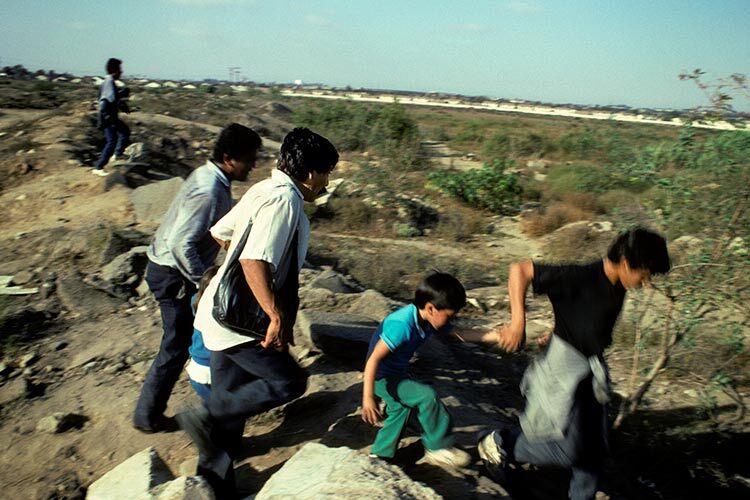About 40 years ago, when Alejando Zaldívar traveled the roads of Mexico with his family, the windshield of their car used to end up covered by different insects that would crash into it. Over the years, their numbers were reduced until there were almost none left to cross their path.
This was an omen of what is now described as a global insect decline. It is estimated that around 40% of them are in danger of extinction.
“At the beginning of 2000, based on anecdotal accounts, a reduction in their populations began to be detected,” says Zaldívar, a researcher at the Institute of Biology of the National Autonomous University of Mexico (UNAM) and curator of the National Insect Collection, in an interview with TecScience.
Some entomologists –the specialists who dedicate their lives to studying this group of animals– had noticed that particular species were disappearing, but scientific research was slow to prove it.
“Since the 80s, it began to be recognized that many species were threatened, but insects were always left aside,” says Alex Córdoba, researcher at the UNAM Institute of Ecology.
According to the experts, this is due to the fact that visually they may be less charismatic than pandas, jaguars, bears or wolves –species that we have long worked to conserve– but also due to the complexity of studying them.
“Many of them are tiny, so it is virtually impossible to know precisely how many species inhabit a place and how their populations have changed,” Zaldívar says.
Despite the biases caused by the lack of information about their populations, there is no doubt about the fact that insects are among the organisms most threatened by human activity.
This crisis should worry us all because they are essential for pollination, the return of nutrients to the soil and the natural control of harmful species.
“Without these organisms, life as we know it will cease to exist,” warns Córdoba.
Fewer and Fewer Insects are Recorded Worldwide
In 2017, a group of researchers reported a 76% decline in flying insect populations by tracking their presence in protected areas in Germany over 27 years. This was a turning point in the study of this problem.
“If this was happening in Europe, where the diversity of insects is not so vast, what was happening in the tropics?” Zaldívar remembers wondering this.
A year later, in the Luquillo rainforest in Puerto Rico, a 98% decrease in terrestrial insects was reported, associated with higher temperatures.
By 2019, the alarms went off after a study analyzed the 73 most relevant articles on their demise. It found a 41% decline in species around the world, with butterflies, beetles, bees, bumblebees and dragonflies among the most affected.

In Mexico, this year monarch butterflies occupied 59% less territory in the center of the country, compared to the previous year. This registry has existed since 1993 and since then, only in 2013 were there so few of this iconic flying species.
All of this articles paint a picture that is worrying enough, without considering that there are still large gaps of information about lesser-known species and, according to experts, there is no reason to assume that they are doing better.
“We are facing a mass extinction of invertebrates, particularly insects,” says Zaldívar.
Responsible for the Harmony in Ecosystems
Although many of us associate insects with species that annoy us –such as mosquitoes or cockroaches– these organisms represent 56% of the diversity of animals on the planet.
“In terms of abundance, nine out of ten are insects,” says Córdoba.
Of these, less than 1% represent those that are harmful to humans; the rest fulfill roles that are essential for the stability of ecosystems and the well-being of the planet.
Some species, such as bees, bumblebees, crickets, butterflies, flies, moths and wasps are pollinators of a great diversity of plants, including those that grow pears, walnuts, strawberries, tomatoes or pumpkins.

Agents of Public Health
Without them, agriculture is virtually impossible and, therefore, livestock farming as well. “If there are no plants, what are the cows and pigs that we feed on going to eat?” Zaldívar asks.
Others, such as ants and beetles, are responsible for decomposing organic matter and returning nutrients to the soil, contributing to their health.
There are also those that serve as natural control of other species, including those that we consider pests.
In a recent study, Córdoba and his team found that in a park in Cuernavaca, Mexico, when the populations of a species of dragonfly decreases, mosquitoes proliferate, associated with the appearance of diseases such as dengue, chikungunya and Zika.
“This is just one example of the importance of some species of insects in terms of public health,” emphasizes Córdoba.
If these reasons are not enough to pay attention to their conservation, experts invite us to question ourselves from a philosophical perspective: insects are as important –or even more– than human beings and having to justify their importance and right to exist based on the benefits they bring us is an anthropocentric vision.
Why are They Sisappearing?
Regarding the causes behind the decline in insect populations, researchers point out that, although they are varied, they are all due directly or indirectly to human activity.
“Extinction processes on the planet have always existed, but the way we have proceeded in the last 30 years has been terrible,” says Córdoba. “We are very far from a natural extinction process.”
One of the most important factors is the use of insecticides in agriculture and private homes.
So is the loss of habitat due to land use change. By replacing ecosystems such as jungles with monoculture grasslands, the biodiversity they can sustain is severely reduced.
Pollution and misuse of water from rivers, lakes and lagoons is also an important cause since many species depend on it to nest and reproduce.
The environmental crisis, global warming and decreased rainfall are particularly harmful since a large number of insects depend on specific temperature and humidity ranges to survive.
“It is thought that insects are all super resistant, like cockroaches, but most of them are as fragile as pandas,” says Zaldívar. “Those that will probably survive are the most resilient ones, and many of them are considered pests, such as flies, cockroaches and mosquitoes.”
The sale of edible insects that are the product of collection instead of breeding, the illegal sale of species that are considered exotic, and light pollution also contribute to this catastrophe.
“All this is related to our lifestyle, where we privilege comfort above all things,” says Córdoba. “It is a rampant economy that believes that the nature where this wealth comes from is endless, but it is not.”
How Can We Prevent Them from Disappearing?
Although the situation is devastating, as individuals there are things we can do to help stop the damage we have caused.
“We think that it is not in our power to help, but of course we can,” says Zaldívar.
The first recommendation is to choose to have plants that are native to our region, which can serve as a food sources for local insects. These, or insect hotels, can be placed on windows, roofs or balconies.
If we have a garden, it is better to replace grass with weeds and local flora that grow freely.
We can also replace insecticides that contain harmful substances –for our health and that of other animals– with less harmful repellents, such as essential oils.
“They take a little longer to take effect, but they are just as efficient,” says Córdoba.
Recently, he, along with a group of researchers and students, published two special issues of the Mexican Scientific Society of Ecology Bulletin on the extinction of insects, where they include a section of practical advice to contribute to the issue.
In it, they lists some native species of flowering plants from some of the most important cities in the country, as well as a series of natural alternatives that serve as repellents or insecticides, to replace synthetic ones.
“You can also contact us directly if you have any questions or want to contribute,” invites Córdoba.
In addition, it is important to discard the medications that we no longer use in drugstores so that they dispose of them appropriately.
Prioritizing foods that have been obtained or created sustainably and safeguarding water sources are also effective measures available to everyone.
“We must protect those we don’t see, not just the ones that are beautiful and shown on television,” Zaldívar concludes.
Did you find this story interesting? Would you like to publish it? Contact our content editor to learn more at marianaleonm@tec.mx















